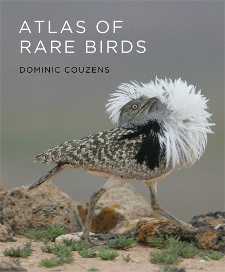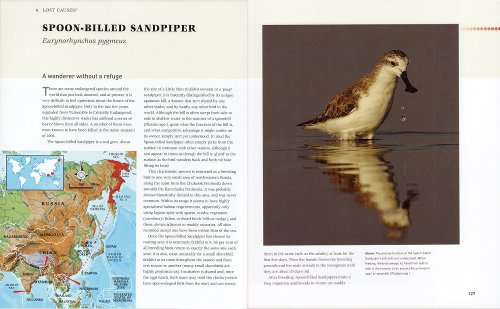Reviewed by Grant McCreary on July 13th, 2011.
Way back in elementary school, while classmates checked out adventure stories from the library, I chose bird books. (Yeah, big surprise!) For some reason, I had a particular interest in endangered species. Were it available then, I would have loved Atlas of Rare Birds.
That’s not to say that I don’t like it now (I do), or that it’s a children’s book (it’s not). Rather, I enjoyed it now, and would have then, because the book is incredibly interesting. Dominic Couzens tells the story of 50 endangered birds, including how they became rare and how they’re faring today.
Instead of selecting the fifty most endangered birds or his personal favorites, the author has chosen birds that exemplify ten different categories. This was a good approach, as it keeps the accounts from becoming repetitive and presents a more complete picture of the issues affecting bird populations. Four pages are devoted to each bird, including a range map and multiple photographs, and five birds represent each category. The categories are:
- Back from the Brink – birds whose populations have sunk precipitously low, but have since recovered a great deal
- The Perils of Island Living – species whose restricted ranges make them vulnerable
- Threats in Many Guises – a sample of the more unusual threats faced by birds
- Migrants in Danger – highlights the difficulties in protecting birds that don’t stay in one place
- Unexpected Calamities – once common, even abundant, birds that could now be in danger
- Lost Causes? – those whose futures seem to be more dire than most
- Controversies – where the interests of birds and people are in conflict
- Discoveries – recent, unexpected, and unusual discoveries
- Rediscoveries – birds found again after being missing, or presumed extinct
- The Pending Tray – the most famous and mysterious of the currently “missing” birds
Most readers will be familiar with some of these birds and their stories, such as the Ivory-billed Woodpecker, California Condor, and Whooping Crane. Others you may have heard of, like Kakapo (thanks to David Attenborough’s The Life of Birds series) or Spoon-billed Sandpiper (justly receiving a great deal of conservation attention recently). But many will likely be completely exotic and unknown to you. The White-eyed River Martin, for instance, is “one of the greatest enigmas of Asian ornithology”. The first one ever recorded was a trapped bird at a Thailand lake in 1968. A few more were captured by ornithologists and there were some sight records until 1980, but nothing since. No one knows where it came from or where it went. Even more amazing is the Nechisar Nightjar, which has never definitely been seen alive. It’s only known from a single severed wing found on an Ethiopian road.
The river martin and nightjar are examples from the pending tray and discoveries chapters, respectively. These two sections, along with the rediscoveries, are the most intriguing to me. But the rest are just as good and arguably more significant, although the potential “lost causes” can be difficult to read about. There are some sad stories here, to be sure, but there is also hope. Many of the birds presented here have been brought “back from the brink”, as the author puts it. While not safe by any means, their circumstances are not nearly as dire as they once were. Their continued existence is nothing short of astounding, and signifies that there is still hope for the rest, too.
Entire books have been written about some of these birds, but Couzens does an excellent job of summarizing their plight in the relatively small amount of space allocated to each species. But even more importantly, his lively writing makes their stories even more interesting than they already are.
Not to be outshone by the text, the photographs and maps are also outstanding. A few of the pictures are sub-par, such as the Whooping Crane on page 98, but most are great – and big. The photos are especially impressive given the rarity of these birds. Further, I love, love, LOVE the maps. They are large, detailed, and extensively labeled. They even include an inset that shows the location(s) on a global scale. These maps set the standard for projects such as this.
Recommendation
The profiles of the 50 endangered birds in Atlas of Rare Birds are incredibly fascinating and well worth reading by anyone who appreciates birds, such as my aforementioned younger self. But as an adult, I find further reason to recommend this book. Couzens does not preach conservation in an overbearing manner, but instead lets the birds’ predicaments speak for themselves. I don’t see how anyone could read much of this book and not want to help.
Disclosure: I get a small commission for purchases made through links in this post.
Disclosure: The item reviewed here was a complementary review copy provided by the publisher. But the opinion expressed here is my own, it has not been influenced in any way.






Comment